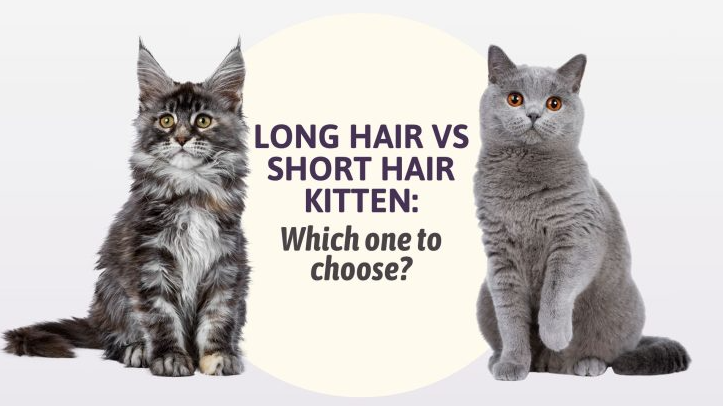Short Hair vs Long Hair Cats: Pros and Cons
As cat lovers, we know that our feline friends come in all shapes and sizes. One of the most noticeable differences is the length of their fur. Some cats have short hair that lies close to their skin, while others have long, flowing locks that require regular grooming. But does hair length really make a difference when it comes to owning a cat? In this article, we’ll explore the differences between short hair and long hair cats, and help you decide which type of cat might be the best fit for you and your lifestyle.

Physical Characteristics: When it comes to physical appearance, short hair and long hair cats have some obvious differences. Short hair cats have a sleek and shiny coat that is easy to maintain, while long hair cats have a more luxurious and fluffy coat that requires regular brushing and grooming. But beyond their fur, there are other physical differences between the two types of cats that may be worth considering. For example, long hair cats tend to shed more than short hair cats, which can be a factor for people with allergies or who prefer a cleaner home.
Key Takeaways
- Short hair cats have a sleek and shiny coat that is easy to maintain, while long hair cats have a more luxurious and fluffy coat that requires regular brushing and grooming.
- Long hair cats tend to shed more than short hair cats, which can be a factor for people with allergies or who prefer a cleaner home.
- Your lifestyle and preferences should be taken into consideration when deciding between a short hair or long hair cat.
Physical Characteristics

Fur Length and Texture
When it comes to fur length and texture, short hair and long hair cats have distinct differences. Short hair cats have a sleek and shiny coat that lies close to their body. The fur is usually smooth to the touch and requires minimal grooming. On the other hand, long hair cats have a fluffy and voluminous coat that can be silky or coarse depending on the breed. The fur can mat easily and requires regular grooming to prevent tangles and knots.
The length and texture of a cat’s fur can also affect their ability to regulate body temperature. Short hair cats are better suited for warmer climates as their fur doesn’t provide as much insulation. Long hair cats, on the other hand, are better equipped for colder climates as their fur provides more warmth.
Grooming Requirements
Short hair cats are generally low-maintenance when it comes to grooming. Their fur sheds less and requires minimal brushing to keep it looking healthy. Long hair cats, on the other hand, require more attention to keep their fur in top condition. Regular brushing is necessary to prevent matting and tangling, and occasional trimming may be needed to keep their fur from becoming too long.
In addition to brushing, both short hair and long hair cats require regular nail trimming, ear cleaning, and dental care. While short hair cats may require less grooming overall, it’s important to remember that every cat is unique and may have different grooming needs.
Overall, the length and texture of a cat’s fur can have a significant impact on their appearance and grooming requirements. By understanding these differences, we can better care for our feline companions and ensure they stay healthy and happy.
Health and Hygiene

Shedding and Allergies
When it comes to shedding and allergies, short-haired cats may be a better option for some people. Short-haired cats typically shed less than long-haired cats, which means less hair on your furniture and clothes. Additionally, short-haired cats may produce fewer allergens than long-haired cats, making them a better choice for those with allergies.
However, it’s important to note that every cat is different and some short-haired cats may still shed a lot or produce a lot of allergens. If shedding and allergies are a concern for you, it’s best to spend some time with a cat before adopting to see how you react to their hair and dander.
Hairball Prevention
Both short-haired and long-haired cats are prone to hairballs, which can be uncomfortable for your cat and messy for you to clean up. Regular grooming can help prevent hairballs by removing loose hair before your cat ingests it.
For long-haired cats, it’s especially important to brush their fur regularly to prevent matting, which can lead to hairballs. Additionally, some cat foods are formulated specifically to help prevent hairballs by promoting healthy digestion and reducing shedding.
Overall, maintaining good hygiene practices such as regular grooming and feeding a healthy diet can help keep both short-haired and long-haired cats healthy and happy.
Behavioral Traits

Activity Levels
When it comes to activity levels, short-haired cats tend to be more energetic and playful compared to their long-haired counterparts. This could be because short-haired cats have less fur to weigh them down, making it easier for them to move around. They also tend to have a higher metabolism, which means they burn more energy and require more physical activity.
On the other hand, long-haired cats are known for being more laid-back and relaxed. They may not be as active as short-haired cats, but they still enjoy playtime and exercise. However, due to their long fur, they may get tired more easily and require more rest.
Social Interaction
Both short-haired and long-haired cats can be social and affectionate with their owners. However, short-haired cats tend to be more outgoing and sociable with strangers, while long-haired cats may be more reserved and cautious.
Long-haired cats also require more grooming and maintenance, which can affect their social interaction. If their fur is not properly groomed, it can become matted and uncomfortable, which may cause them to avoid socializing with people and other animals.
Overall, the activity levels and social interaction of a cat can vary based on their breed, personality, and individual preferences. It’s important to understand the behavioral traits of different cat breeds before bringing one into your home, so you can provide them with the proper care and environment they need to thrive.
Maintenance and Care

When it comes to maintaining and caring for cats, the length of their hair plays a significant role. Short-haired cats require less grooming and maintenance than long-haired cats. However, both types of cats need proper care to keep them healthy and happy.
Grooming Tools
Cats are self-groomers, but they still require regular grooming to keep their coat healthy and shiny. Short-haired cats need to be brushed once a week, while long-haired cats require daily brushing to prevent matting and tangling.
For short-haired cats, a soft-bristled brush or a rubber grooming glove is enough to remove loose hair and dirt. On the other hand, long-haired cats need a slicker brush, a comb, and a dematting tool to remove tangles and mats.
Professional Grooming Services
While regular grooming at home is essential, professional grooming services can also help maintain your cat’s hygiene. Professional groomers can trim your cat’s nails, clean their ears, and give them a bath to keep them clean and healthy.
Long-haired cats may require professional grooming services more often than short-haired cats. This is because long-haired cats are more prone to matting and tangling, which can be challenging to remove at home.
In conclusion, both short-haired and long-haired cats require proper maintenance and care to keep them healthy and happy. With the right grooming tools and occasional professional grooming services, you can ensure your cat’s coat stays healthy and beautiful.
Adoption Considerations
When considering adopting a cat, one of the most important factors to consider is the length of their coat. Here are some key factors to consider when making your decision:
Breed Availability
Certain breeds of cats are more likely to have long or short hair. For example, Persian cats are known for their long, luxurious coats, while Siamese cats typically have short, sleek fur. If you have your heart set on a particular breed, it’s important to research the typical length of their coat before you adopt.
Living Environment
Your living environment is another important factor to consider when choosing between a short hair or long hair cat. If you live in a small apartment or have limited space, a short hair cat may be a better fit, as they require less grooming and shed less than their long hair counterparts. On the other hand, if you have a larger home and are willing to put in the time and effort to groom your cat regularly, a long hair cat may be a great choice.
No matter which type of cat you choose, it’s important to remember that all cats require love, attention, and care. By considering your lifestyle and preferences, you can make an informed decision and provide a loving home for your new feline friend.
Frequently Asked Questions
What are the differences in grooming requirements between short hair and long hair cats?
Short hair cats generally require less grooming than long hair cats. They may only need to be brushed occasionally to remove loose fur and keep their coat shiny. Long hair cats, on the other hand, require more frequent brushing to prevent matting and tangling of their fur. They may also need to be trimmed or shaved in warmer months to prevent overheating.
Which type of cat is better for individuals with allergies, short hair or long hair?
Individuals with allergies may be better suited to short hair cats, as they tend to shed less than long hair cats. However, it is important to note that all cats produce allergens, so it is best to spend time with a cat before adopting to ensure that you do not have a reaction.
How does shedding compare between short hair and long hair cat breeds?
Long hair cats tend to shed more than short hair cats due to the length and thickness of their fur. Short hair cats may still shed, but it is usually less noticeable and easier to manage.
Are there any behavioral differences between short hair and long hair cats?
There are no inherent behavioral differences between short hair and long hair cats. However, it is important to note that individual cats may have their own unique personalities and behaviors.
What should be considered when deciding between adopting a short hair or long hair cat?
When deciding between a short hair or long hair cat, it is important to consider your lifestyle and grooming preferences. If you have limited time for grooming, a short hair cat may be a better fit. If you enjoy grooming and have the time to dedicate to it, a long hair cat may be a good choice.
Can cats have a mix of short and long hair, and how does it affect their care?
Yes, cats can have a mix of short and long hair. These cats are often referred to as “medium hair” or “semi-long hair” cats. Their grooming requirements may vary depending on the length and texture of their fur, but they generally require more grooming than short hair cats and less than long hair cats. Regular brushing and occasional trimming may be necessary to keep their coat healthy and free of matting.


It’s perfect time to make some plans for the future and it’s time to
be happy. I have read this post and if I could I wish to suggest
you few interesting things or suggestions. Perhaps you could write next articles referring
to this article. I desire to read more things about it!
There’s definately a lot to find out about this issue.
I love all the points you’ve made.